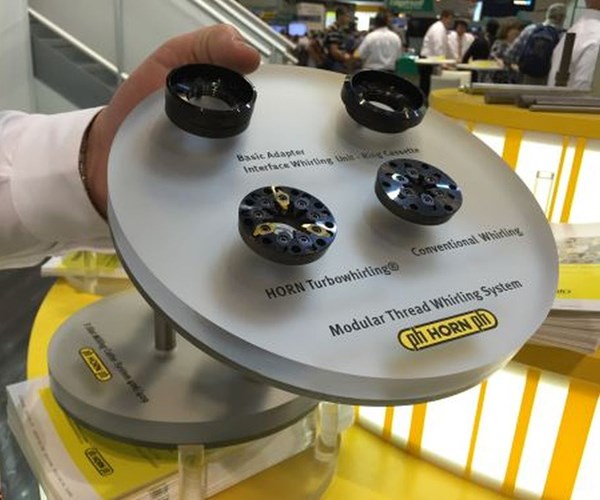Take This Tool for a Spin
Turbo whirling is a newly developed process from Horn USA that optimizes machining during thread whirling, boosting both productivity and cost-effectiveness.

You can see how the cutting division concept of the nine-insert tool allows machining to be divided up so that each cutting edge is subject to equal load, leading to significantly longer service lives.
While visiting the Horn USA booth at IMTS 2016, the subject arose about which new machining process was being placed front and center for visitors to see. The answer? Turbo whirling. In a nutshell, turbo whirling is a newly developed process that optimizes machining during thread whirling, thus increasing cost effectiveness. According to Horn, it has developed a set of cutting tools for whirling that feature a new cutting division concept specifically designed for machining threads with a large allowance.
It seems that individual cutting edges work as pre-cutters and machine the workpiece to the defined external diameter. In the case of a nine-insert tool, the company says, the cutting division concept allows the machining work to be divided up so that each cutting edge is subject to equal load. This means that individual cutting edges can achieve significantly longer service lives. The finishing cutting edges produce the finished thread flanks within the optimized working range. In addition, regardless of the external workpiece diameter, combining a range of cutting edge profiles creates an optimum thread with reproducible tool lives.
Horn says turbo whirling can be used to produce single-start and multi-start threads and profiles. What’s more, the S271 precision-ground double-edged indexable inserts are tailored to the respective thread profile and the material to be machined. The indexable inserts are clamped in positive-fit, highly stable insert seats, either in the new modular whirling heads with optimized handling during insert replacement or conventionally in the Mono block tools. Read about Thread Whirling Basics in this article from a past issue of Production Machining.
RELATED CONTENT
-
Making Micro Threads
Production of micro threads can be challenging, but using the most suitable tools for a given application can simplify the task.
-
Cutting Tool Coating Production
This article looks at the coating methods available for carbide cutting tools.
-
4 Strategies for Managing Chip Control
Having strategies in place for managing chips is an important part of protecting the production process, from tool life to product quality.


